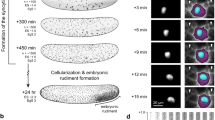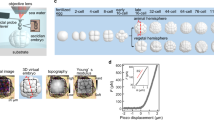Abstract
OBSERVATIONS relevant to analysis of the mechanisms of cell division have been made by using a preparation of cleaving eggs of Ciona intestinalis. The dividing eggs are compressed in a shallow chamber to about one-fifth of their original thickness of near 150µ. The drop of sea-water containing the eggs is surrounded by liquid paraffin, which prevents evaporation and allows gaseous exchange. The egg is confined within a chorion which remains during the course of development. Uncompressed eggs under these conditions develop to normal tadpoles. Compression aligns all the spindle axes in a horizontal plane. During cleavage the blastomeres show a well-defined period of ‘contraction’ during the development of the cleavage furrow and a period of ‘relaxation’ which is recognized by the disappearance of the cleavage furrow and, under the present conditions, by the egg once more filling the whole of the space within the chorion. Analysis of a sequence of cleavages of such a preparation by time-lapse ciné-photography has revealed that surfaces which come into contact during the relaxed phase may adhere together and, remaining in contact, take no further part in subsequent relaxation–contraction cycles. Fig. 1A–F shows such a preparation from the end of the second cleavage to the contraction period of the fourth. In Fig. 1C the blastomeres are in the relaxed phase and the new cleavage surfaces are in contact; Fig. 1D shows the beginning of the contraction phase of the third cleavage while the first and second cleavage surfaces are still in the relaxed configuration. The third set of cleavage surfaces remains ‘uncontracted’ during the fourth cleavage (Fig. 1F). This behaviour seems a special case of contact inhibition and may be an important factor in morphogenesis. It is clear that it is not essential for the surface at the astral poles to relax or expand during cleavage, as in these preparations it is the inhibited surface which is polar to the aster–spindle–aster axis.
This is a preview of subscription content, access via your institution
Access options
Subscribe to this journal
Receive 51 print issues and online access
$199.00 per year
only $3.90 per issue
Buy this article
- Purchase on Springer Link
- Instant access to full article PDF
Prices may be subject to local taxes which are calculated during checkout
Similar content being viewed by others
References
Danielli, J. F., Nature, 170, 496 (1952).
Selman, G. G., and Waddington, C. H., J. Exp. Biol., 32, 700 (1955).
Swann, M. M., and Mitchison, J. M., Biol. Rev., 33, 103 (1958).
Wolpert, L., Intern. Rev. Cytol., 10, 163 (1960).
Author information
Authors and Affiliations
Rights and permissions
About this article
Cite this article
BELL, L. Some Mechanisms involved in Cell Division. Nature 193, 190–191 (1962). https://doi.org/10.1038/193190a0
Issue Date:
DOI: https://doi.org/10.1038/193190a0
Comments
By submitting a comment you agree to abide by our Terms and Community Guidelines. If you find something abusive or that does not comply with our terms or guidelines please flag it as inappropriate.



